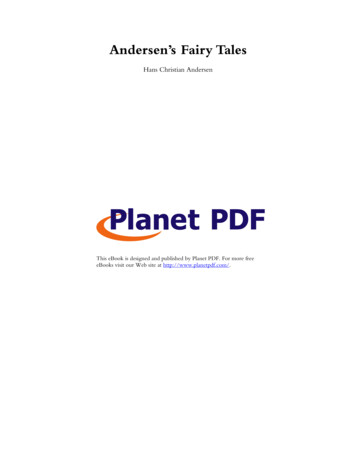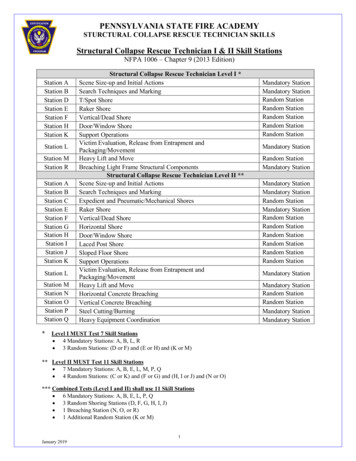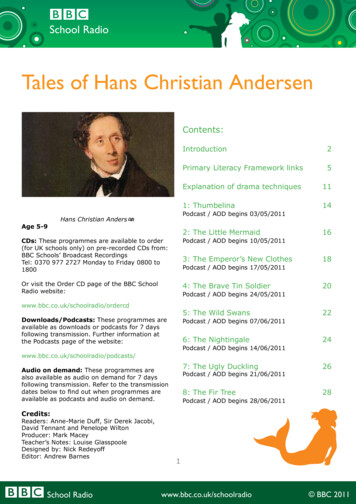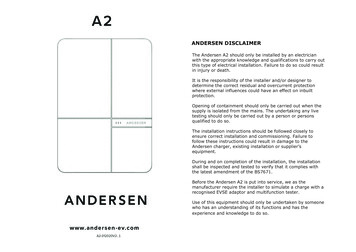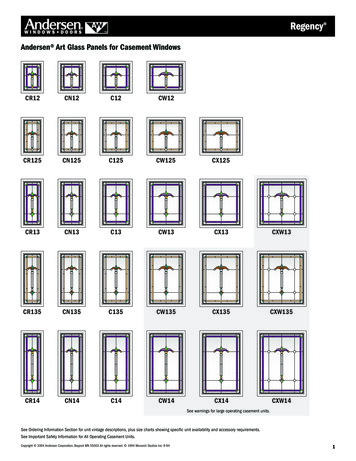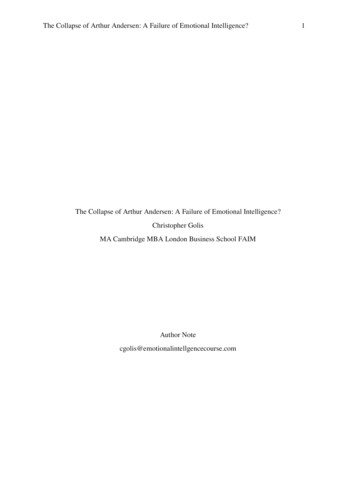
Transcription
The Collapse of Arthur Andersen: A Failure of Emotional Intelligence?The Collapse of Arthur Andersen: A Failure of Emotional Intelligence?Christopher GolisMA Cambridge MBA London Business School FAIMAuthor Notecgolis@emotionalintellgencecourse.com1
The Collapse of Arthur Andersen: A Failure of Emotional Intelligence?2AbstractOne of the five key themes of ICEI 2019 is Emotional Intelligence in the Professions. Oneof my core beliefs is that you learn more from your mistakes than your successes. So, if thisconference is meant to be a learning opportunity, we should examine mistakes that haveoccurred in the Professions. In my lifetime the greatest Professional “mistake” would have tobe the collapse of Arthur Andersen. The company regarded as the Gold Standard in the USAfor ethics and corporate governance went from 85,000 employees to 16 in 2002. In this paperI will argue that the real cause of this collapse was a failure of emotional intelligence.The paper is structured as follows:1.A summary of the history of Arthur Andersen including prevailing beliefs for itscollapse.2.The real reason for its collapse: the adoption of Myers Briggs (MBTI) as its peopleprofiling methodology.3.A review of the MBTI methodology.4.A review of the criticisms of MBTI including its fatal flaw.5.How the MBTI fatal flaw destroyed Arthur Andersen.6.What are the possible emotionally intelligent people profiling systems the Professionsshould use?At the 2017 Oporto conference the most popular Emotional Intelligence model used was theSalovey-Myer RULER model of Recognizing, Understanding, Labelling, Expressing, andRegulating emotions . At the conference Marc Brackett described the Mood Meter App tohelp you RULER your emotions. According to Brackett an individual goes through hundredsof positions on the Mood Meter every day which frankly makes it an impractical tool forcommercial use. What organisations need and want is a tool that profiles a person’semotional predispositions. More importantly it should help an organisation screen outcorporate psychopaths and corporate bullies.(298 words)
The Collapse of Arthur Andersen: A Failure of Emotional Intelligence?3“We do not learn from experience. we learn from reflecting on experience.”― John DeweyOne of the five major themes of this conference is Emotional Intelligence in the Professions.One of my core beliefs is that you learn more from your mistakes than your successes. So, ifthis conference is meant to be a learning opportunity we should examine “mistakes” that haveoccurred in the Professions. In my lifetime the greatest Professional “mistake” would have tobe the collapse of Arthur Andersen in 2002. The company regarded as the Gold Standard inthe USA for ethics and corporate governance went from 85,000 employees to 16 in one year.In this paper I will argue that the cause of this collapse was a failure of emotional intelligence.History of Arthur AndersenArthur Andersen was founded in December 1913. The next year Andersen himself was askedby the president of a local railroad, which was also its largest client, to approve a "peculiar"transaction. His reply was famous in annals of American business history."Not enough money in the city of Chicago to make me do that."Andersen was replaced as the auditor but the railroad company filed for bankruptcy monthslater. And so the Arthur Andersen legend was born. Of all the major auditing firms Andersenwas regarded as the most logical and principled. The motto of the company became "Thinkstraight, talk straight".AA was the first major auditing firm to introduce management consulting. This had greatpotential for conflict of interest as it would be difficult to qualify the audit of a major consultingclient. To ensure probity Andersen introduced the Method; everything was codified and doneby the book (presentations, hiring staff, etc). Every office had a senior partner for probity whoacted as the methodology coordinator and keeper of the flame of integrity.Evolution of Professional Standards GroupIn addition Andersen Consulting (which became Accenture) physically separated fromAndersen Auditing in 1988. After the separation of Andersen Consulting, Andersen Auditingdecided to re-enter the consulting market at the Small Business end (where small was definedas annual sales less than 175 million) to replace declining audit revenues. This again led tointernal and external conflicts. In 1989 Jim Edwards, then Managing Partner—global markets,gave the Eye of the Tiger presentation in Dallas at the Annual Partners Conference. He walkedon to the stage with a tiger on a leash. His message was that it was a jungle out there, and thatevery partner had to double his fee income in three years. Naturally many partners, particularlythose responsible for probity failed to achieve this goal and in 1992 there was the Great PartnerPurge. Profit had replaced probity in the AA culture.There is a book about the collapse: Inside Arthur Andersen: Shifting Values, UnexpectedConsequences written by four former Andersen Consulting Employees. Their argument is thatthe seeds of the destruction of Andersen Auditing were planted when the organisation startedto do consulting work for its clients soon after its beginnings in 1913. The book spends muchtime on the differing and, to the authors, irreconcilable cultures of consulting and auditing.However as several of the Amazon reviews of book have remarked, if the problem is one ofdiffering cultures in an organisation, why haven't the other major accounting firms alsocollapsed because they too all have consulting divisions?So why did Arthur Andersen collapse?
The Collapse of Arthur Andersen: A Failure of Emotional Intelligence?4I am going to argue that the seeds of its destruction were sown in early 1960s when it startedto use the Myers-Briggs Type Indicator (MBTI) as its profiling methodology.Explanation and History of MBTIThe theory of psychological type was introduced in the 1920s by Carl G. Jung. The MBTI toolwas developed in the 1940s by Isabel Briggs Myers and her mother Katherine Briggs duringthe 1940s and '50s. The instrument was first published in 1962. The tool helps you to identifyyour basic preferences of each of the four dichotomies specified or implicit in Jung's theory.A preference is what you like. There are no right or wrong preferences in the four dichotomies:Favourite world: Do you prefer to focus on the outer world or on your own inner world? Thisis called Extraversion (E) or Introversion (I).Information: Do you prefer to focus on the basic information you take in or do you prefer tointerpret and add meaning? This is called Sensing (S) or Intuition (N).Decisions: When making decisions, do you prefer to first look at logic and consistency or firstlook at the people and special circumstances? This is called Thinking (T) or Feeling (F).Structure: In dealing with the outside world, do you prefer to get things decided or do youprefer to stay open to new information and options? This is called Judging (J) or Perceiving(P).When you decide on your preference in each category, you have your own personality type,which can be expressed as a code with four letters which leads in turn to a type table:Since its introduction the MBTI has become the most widely used profiling tool world-wide.It is taken by more than 2.5 million people a year, and is used by 89 of the Fortune 100companies.
The Collapse of Arthur Andersen: A Failure of Emotional Intelligence?5One of the major reasons for its popularity was the family friendship with Edward N. Hay, whowas then personnel manager for a large Philadelphia bank. Neither Myers nor Briggs wasformally educated in the discipline of psychology, and both were self-taught in the field ofpsychometric testing. From Hay, Myers learned rudimentary test construction, scoring,validation, and statistical methods. In 1943, he launched Hay Group, a managementconsultancy that focused on improving the personnel side of businesses, which he believed wasa neglected and underdeveloped area. In 1945, Hay got his first major contract, from GeneralFoods Corporation to study and evaluate 450 management jobs. Hay became one of world’sleading consultancies employing 3,000 people by 2015 when it merged with Korn Ferry.During its 70 years it became a strong advocate of Myers-Briggs.However probably as important to its growth was the adoption of the MBTI by ArthurAndersen in the 1960s. The critical question every technology start-up faces is “Who else isusing it?” Arthur Andersen by the 1960s had so developed a reputation in the Americancommercial world for ethics and governance that it had become the ultimate reference sale.The answer “Arthur Andersen” was all that was necessary to convince the MBTI prospect toconvert to a client.What is the link between Emotional Intelligence and Myers-Briggs? Robin Hills, who runs theEI4Change website, published a paper in 2017 on Emotional Intelligence and the Myers BriggsType Indicator. Robin prefers the 2x2 Goleman competency matrix (Self-Awareness, SelfManagement, Empathy, Social Skills) as his preferred Emotional Intelligence model.His first key message is that Type is fixed, Emotional Intelligence is changeable. Accordingto Robin there are two main ways of considering the relationship between EmotionalIntelligence and Myers Briggs Type. Type will influence the development of EmotionalIntelligence while Emotional Intelligence will influence the development of Type.This interdependence means that Emotional Intelligence influences the effectiveness withwhich Type is expressed, and Type influences the ease with which different characteristics ofEmotional Intelligence are learnt. As a simple example if you are an Introvert you should bebetter at Self-Awareness; but if you are an Extravert you should be better at Social Skills.Flaws of MBTIOne of the most well-known critics of the MBTI is Professor Adam Grant of the WhartonBusiness School. His latest critique listed the following flaws:Poor ReliabilityA test is reliable if it produces the same results from different sources. Type is meant to befixed but the MBTI test is not reliable. Over half of people taking the MBTI a second time -personality-test-not-reliable-416652Research shows “that as many as three-quarters of test takers achieve a different personalitytype when tested again,” writes Annie Murphy Paul in The Cult of Personality Testing, “andthe sixteen distinctive types described by the Myers-Briggs have no scientific basiswhatsoever.” In a recent article, Roman Krznaric adds that “if you retake the test after only afive-week gap, there’s around a 50 percent chance that you will fall into a different personalitycategory.”
The Collapse of Arthur Andersen: A Failure of Emotional Intelligence?6Poor ValidityA test is valid if it predicts outcomes that matter. If we’re going to use it in organizations, itshould shed light on how well I’ll perform in a particular job or with a certain group of people.Although there are data suggesting that different occupations attract people of different types,there is no convincing body of evidence that types affect job performance or team effectiveness.As management researchers William Gardner and Mark Martinko write in a comprehensivereview, “Few consistent relationships between type and managerial effectiveness have beenfound.”Poor Taxonomy of CategoriesCategories are mutually exclusive if they capture different traits that are separate, and combinetraits that have commonalities. In the MBTI, thinking and feeling are opposite poles of acontinuum. In reality, they’re independent: we have three decades of evidence that if you likeideas and data, you can also like people and emotions. (In fact, more often than not, they gohand in hand: research shows that people with stronger thinking and reasoning skills are alsobetter at recognizing, understanding, and managing emotions.) The first time Grant took theMBTI he scored as a Thinker, and next time he was as a Feeler.The feeling type is supposed to tap into your orientation toward people and emotions. But thislumps together three separate traits that capture a positive orientation toward others, thetendency to feel negative emotions, and the receptivity toward these emotions.No measure of emotional stabilityA comprehensive test assesses the major categories that exist. One of the key elements missingfrom the MBTI is what personality psychologists call emotional stability versus reactivity —the tendency to stay calm and collected under stress or pressure. This turns out to be one of themost important predictors of individual and group patterns of thought, feeling, and action.Poor measure of conscientiousnessThe judging-perceiving scale captures whether I’m an organizer and a planner, but overlooksthe industriousness and achievement drive that tend to accompany these characteristics —together, they form a personality trait called conscientiousness. As personality psychologistsRobert McCrae and Paul Costa sum it up, “the MBTI does not give comprehensive informationon the four domains it does sample.”The Mega-MisconceptionSecondly Extraversion is on a spectrum. To divide people into two types is to create what HansRosling calls The Mega Misconception that "The Word is Divided in Two". We all suffer fromthe irresistible temptation to divide all kinds of things into two distinct and conflicting groups,with an imagined gap in between. (This is best explained in the first chapter of Hans Rosling’sbook Factfulness: Ten Reasons We're Wrong About the World - and Why Things Are BetterThan You Think). The reality is that most things are dispersed on a spectrum that is spreadalong the Normal Distribution or Bell Curve. One sixth of us are Extraverts, one sixthintroverts, and two-thirds in between are Ambiverts.So even introversion-extraversion, the trait the MBTI captured best, is incomplete. Accordingto the MBTI, extraversion is about where you get your energy: from the outside world or theinner world. This is partially right, but it’s not because of a preference for interacting withpeople. Our scores are heavily shaped by how our brains process neocortical arousal. As SusanCain explains in Quiet, “more than a thousand studies conducted by scientists worldwide”
The Collapse of Arthur Andersen: A Failure of Emotional Intelligence?7suggest that introverts “are more sensitive than extroverts to various kinds of stimulation, fromcoffee to a loud bang to the dull roar of a networking event.” Besides, it turns out that like allpersonality traits, introversion-extraversion is shaped like a bell curve: it’s more common to bein the middle. Sixty-seven percent of us are ambiverts: in Dan Pink’s words from To Sell isHuman, most people are “neither overly extraverted nor wildly introverted.”No recognition of the Corporate PsychopathThis to me is the Fatal Flaw of the MBTI; it fails to recognise corporate psychopaths. I willdiscuss corporate psychopaths in more detail in the next section but psychopathy is a traitnormally distributed in the population. So 15% of the population have psychopathy as a strongtrait. The MBTI does not walk alone in this regard. The other major people profiling systems,DISC and the Big Five, do not recognise psychopaths either.Corporate PsychopathsThe seminal work on corporate psychopaths is Snakes in Suits: When Psychopaths Go to Workby industrial psychologist Paul Babiak and criminal psychologist Robert D. Hare published in2006. In 2008 I attended a seminar by Dr John Clarke, a lecturer in Psychology at theUniversity of Sydney, consultant to the NSW Police Force, and widely regarded as Australia'sexpert on corporate psychopaths. There were over 100 attendees, of which around 90% werefemales who had suffered at the hands of a corporate psychopath and were looking for revenge.Clarke put up the following checklist to enable you to recognise the corporate psychopath: Charming but frequently lie (very flexible)Does whatever it takes to close a dealTake credit for other peoples’ workGuiltlessly blame co-workers and subordinates, never remorsefulSelf-focused and act self-importantGood at manipulating people emotionallyMultiple sexual encountersNever ask permission but if caught out will sincerely ask for forgivenessI remember when I saw this checklist how similar it was to the Hustler checklist when I firstlearned the Humm-Wadsworth in 1974.Dr Clarke said that prospective employers should look for two things on a potential employee'sresume: frequent job changes and limited educational qualifications. Corporate psychopathscan create a very good initial impression but often their peers soon become intolerant of theirworkplace habits. In particular, people dislike the taking of credit for the ideas of others, andthe blaming of others (typically an underling) for mistakes. Corporate psychopaths are verygood at sensing this antipathy, and so change jobs frequently; often leveraging themselves intoa higher position.Schools and universities ultimately judge their students on their academic results, which formost of us means work. Psychopaths are often inherently lazy, and their charm and peopleskills are of little help in the examination room. People with nothing to hide will elaborate ontheir education, specifying dates, subjects done, awards and extracurricular activities. Theeducation section of a resume, after all, is something that is very easy for an employer to verify.If there have been issues, and with psychopaths there generally are, the education entry willoften be pitifully short and devoid of detail.
The Collapse of Arthur Andersen: A Failure of Emotional Intelligence?8Hand in hand with the corporate psychopath is the Dark Triad which refers to the personalitytraits of narcissism, Machiavellianism, and psychopathy. All three dark triad traits areconceptually distinct although empirical evidence shows them to be overlapping. They areassociated with a callous-manipulative interpersonal style: Narcissism is characterized by grandiosity, pride, egotism, and a lack of empathy.Machiavellianism is characterized by manipulation and exploitation of others, a cynicaldisregard for morality, and a focus on self-interest and deception.Psychopathy is characterized by continuing antisocial behaviour, impulsivity,selfishness, callousness, and remorselessness.Hare developed a psychopathy checklist in the 1970s which as since been revised and is knownas the PCL-R or Psychopathy Checklist—Revised. The Dark Triad has its own checklistknown as Short Dark Triad. It was developed in 2011 by Delroy Paulhus and Daniel Jones andconsists of twenty-seven statements that must be rated on how much you agree with them. Thetest should not take most people more than five minutes.Sometimes researchers combine the Big Five with the Short Dark Triad. One study in 2017involved hundreds of Danish students enrolled to begin studying either psychology,politics/law, or business/economics who first took a combination of the Big Five and DarkTriad personality tests. The study discovered Business/economics students scored the highestof all on the Dark Triad, followed by Law/Politics and then psychology.Why Arthur Andersen failedThis is why Andersen collapsed. It was not just the introduction of profit culture (that had beenthere from the beginning) but because Andersen was now being led by corporate psychopathswho had slipped through the MBTI net. Unfortunately, Myers-Briggs is really a profilingtechnique which is based on how we make decisions. It does not tell you whether someone hasPsychopathic, Narcissistic or Machiavellian traits. This is not the first time a corporatepsychopath is selected as CEO and subsequently caused the destruction of an organisation andit will not be the last.Moreover, there is a second problem. If Arthur Andersen was using an Emotional Intelligencetest it would not have improved the situation. At the 2017 Oporto conference the most popularEmotional Intelligence model used was the Salovey-Myer RULER model of Recognizing,Understanding, Labelling, Expressing, and Regulating emotions. At the conference MarcBrackett described the Mood Meter App to help you RULER your emotions. According toBrackett an individual goes through hundreds of positions on the Mood Meter every day whichfrankly makes it an impractical tool for commercial use. What organisations need and want isa tool that profiles a person’s emotional predispositions. More importantly it should help anorganisation screen out corporate psychopaths and corporate bullies.New evidence shows that when people hone their emotional skills, they become better atmanipulating others. When you’re good at controlling your own emotions, you can disguiseyour true feelings. When you know what others are feeling, you can tug at their heartstringsand motivate them to act against their own best interests.Recognizing the power of emotions, one of the most influential leaders of the 20th centuryspent years studying the emotional effects of his body language. Practicing his hand gesturesand analysing images of his movements allowed him to become “an absolutely spellbindingpublic speaker,” says the historian Roger Moorhouse, “it was something he worked very hardon.” His name was Adolf Hitler.
The Collapse of Arthur Andersen: A Failure of Emotional Intelligence?9In a study led by the University of Toronto psychologist Stéphane Côté, university employeesfilled out a survey about their Machiavellian tendencies, and took a test measuring theirknowledge about effective strategies for managing emotions. Then, Cote’s team assessed howoften the employees deliberately undermined their colleagues. The employees who engaged inthe most harmful behaviours were Machiavellians with high emotional intelligence. They usedtheir emotional skills to demean and embarrass their peers for personal gain.Profiling Systems That Include Corporate Psychopaths as Part of TheirTaxonomy.Unfortunately the MBTI, its major competitor, DISC, and the Big Five do not includepsychopathy as one of the personality components. One profiling system that does is theHEXACO model with six components developed by Kibeom Lee and Michael C. Ashton. TheHEXACO model is complementary to the Five Factor model. It retains the Extraversion,Agreeableness, Conscientiousness, and Openness to Experience factors of the Five Factormodel. The major changes are that it adds the Honesty/Humility factor and replaces the“Neuroticism” factor with an “Emotionality” factor. Lee & Ashton define the H factor asHonesty and Humility. It is on a bell curve spectrum like the Big 5 factors with around 15%of the population having low H. These are the potential corporate psychopaths.Another personality model is the 7MTF/Humm. This model has a long pedigree. In 1924, anAmerican psychologist, Rosanoff, changed the way people thought about mental illness. Untilthe work of Rosanoff, doctors defined abnormal psychological conditions in black and white:people were either mad or not. Rosanoff suggested that such a distinction between the normaland abnormal states was artificial and the difference was not one of kind but of degree.Normality and abnormality are not black and white but as different shades of grey.Rosanoff further noted there were few mental illnesses and proposed a theory of personalitybased on the most common four: schizophreniaepilepsyhysteriacyclodia (what we now would call manic-depression or the bi-polar personalitydisorder)and a fifth component that he called the Normal which is the converse of Neuroticism.In 1933 two southern Californians, Humm, a statistician, and Wadsworth, a clinicalpsychologist, using the newly develop technique multivariate factor analysis extended theRosanoff hypothesis by sub-dividing both cyclodia and schizophrenia into four newcomponents. Cyclodia was divided into manic-depression and schizophrenia divided intoautistic-paranoid. The Humm-Wadsworth model thus had seven personality temperamentcomponents. The original test was published in 1935 and the Humm-Wadsworth TemperamentScale soon became a preferred test for personality profiling.In 2007 I retired from the venture capital industry after 25 years and decided to develop a thirdpart-time career in pushing the Humm-Wadsworth as the secret to lifting your emotionalintelligence. I published The Humm Handbook for managers and created a business runningworkshops, doing EQ coaching and writing some 250 blogs. Over the next nine years theoriginal metal illness list used by Humm & Wadsworth was modified to mania, depression,
The Collapse of Arthur Andersen: A Failure of Emotional Intelligence?10autism, paranoia, obsessive-compulsive disorder, psychopathy and neuroticism. In addition Ialso signed up JV partners in China and the USA.While working with my JV partner in the USA he said the marketability of the technologywould be improved if new names were used to reflect the changes and to avoid confusion weshould rename the model the 7MTF standing for the Seven Motivational-TemperamentFactors. The new names for the Emotional Intelligence Core Components are GoGetter,Regulator, Artist, Socialiser, Politician, Engineer, and Doublechecker which conveniently forma mnemonic: GRASPED. The five most common 7MTF components Artist, Engineer,Socialiser, Doublechecker and Regulator match up with the Five-Factor Model Openness toCreativity, Conscientiousness, Extraversion, Agreeableness, and Neuroticism which providesscientific validity for 7MTF, plus it accounts for the two drivers of toxic leaders: corporatebullies and corporate psychopaths.1935 Epileptoid1993 cianEngineerHysteroidHustlerRevised idObsessiveCompulsiveAnti-Social(DarkTriad)7 nEngineerGoGetterIn summary in the same way that the Humm-Wadsworth is built on foundations of Rosanoff;the 7MTF is built on the work of Humm and Wadsworth.ConclusionArthur Andersen failed because it was fervent user of the MBTI which failed to screen outcorporate psychopaths. Unfortunately, several of them reached the highest echelons of theorganisation and changed the culture. The desire for profit eradicated probity.Regrettably, the current Emotional Intelligence models would not have been a help. Theproblem with these models is that they argue that it is the transient emotions that are important.I disagree. I believe that what is essential in lifting your Emotional Intelligence is anunderstanding of temperament, which is that part of the personality that is genetically basedand is what determines our habitual emotional responses.Caruso and Salovey do refer in passing to some people having typical ways of looking at theworld and call these dispositional traits. I would argue the opposite and say all of us have coredispositional traits and that it the mixture of these traits with some being dominant and othersweak that make us all unique. The model that I have found best at explaining temperament isthe 7MTF. This model says we are all slightly insane and as I get older, I am more and morerelaxed about this hypothesis. The model also says we have seven core emotional drives basedon the seven most common forms of mental illness.I started this paper with one quotation and I will finish with another:
The Collapse of Arthur Andersen: A Failure of Emotional Intelligence?11“The tragedy about history - personally and globally - is that while we may learn it we rarelylearn from it.” ― Rasheed Ogunlaru
be the collapse of Arthur Andersen in 2002. The company regarded as the Gold Standard in the USA for ethics and corporate governance went from 85,000 employees to 16 in one year. In this paper I will argue that the cause of this collapse was a failure of emotional intelligence. History of Arthur Andersen Arthur Andersen was founded in December .


